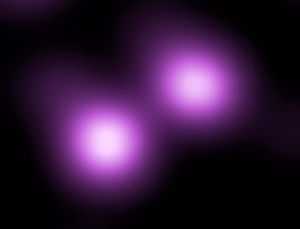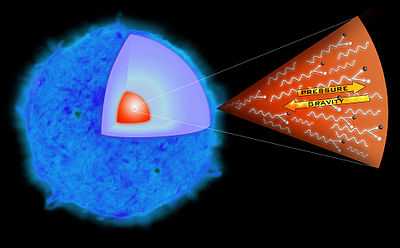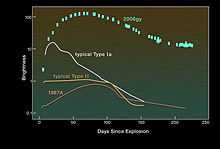SN 2006gy
| SN 2006gy | |
|---|---|
 SN 2006gy and the core of its home galaxy, NGC 1260, viewed in x-ray light from the Chandra X-ray Observatory. The NGC 1260 galactic core is on the lower left and SN 2006gy is on the upper right. | |
| Observation data (Epoch J2000) | |
| Supernova type | Pair-instability |
| Remnant type | N/A |
| Host galaxy | NGC 1260 |
| Constellation | Perseus |
| Right ascension | 03h 17m 27.10s[1] |
| Declination | +41º 24' 19.50"[1] |
| Galactic coordinates | 150.2568 -13.5916 |
| Discovery date | 18 September 2006 N/A |
| Peak magnitude (V) | +14.2 |
| Distance | 238,000,000 Ly (72 Mpc)[citation needed] |
| Physical characteristics | |
| Progenitor | Hypergiant Star in NGC 1260 Galaxy |
| Progenitor type | Hypergiant Star |
| Colour (B-V) | -0.50 ~ +1.60 |
| Notable features | is located 2.0" W and 0.4" N of the center of NGC 1260. |
SN 2006gy was an extremely energetic supernova, sometimes referred to as a hypernova or quark-nova,[2] that was discovered on September 18, 2006. It was first observed by Robert Quimby and P. Mondol,[1][3] and then studied by several teams of astronomers using facilities that included the Chandra, Lick, and Keck Observatories.[4][5] On May 7, 2007, NASA and several of the astronomers announced the first detailed analyses of the supernova, describing it as the "brightest stellar explosion ever recorded".[6] In October 2007 Quimby announced that SN 2005ap had broken SN 2006gy's record as the brightest ever recorded supernova.[7] Time magazine listed the discovery of SN 2006gy as third in its Top 10 Scientific Discoveries for 2007.[8]
Characteristics

SN 2006gy occurred in a distant galaxy (NGC 1260), approximately 238 million[citation needed] light years (72 megaparsecs) away. Therefore, due to the time it took light from the supernova to reach Earth, the event occurred about 238 million years ago. Preliminary indications are that it was an unusually high-energy supernova of a very large star, around 150 solar masses (M⊙), possibly of a type referred to as a pair-instability supernova. The energy released by the explosion has been estimated at 1052 ergs (1045 J).[5]

A pair instability supernova can only happen in stars that are very massive— having a range of around 130 to 250 solar masses. At a certain point in such a massive star's life its core begins to produce high energy gamma rays which have a greater energy than the rest mass of two electrons (mass-energy equivalence). These high energy gamma rays strike atomic nuclei and are converted from energy (or heat) to matter, disrupting the equilibrium between thermodynamic pressure and gravity in the star's core. The sudden drop in thermodynamic pressure causes the core to collapse. As the core collapses it gets hotter and hotter until a runaway thermonuclear reaction begins. In a few seconds, all of the fuel in the core undergoes a cataclysmic thermonuclear fusion, blowing the star completely apart while leaving nothing behind.[9]

Although the SN 2006gy supernova was intrinsically about one hundred times as luminous as SN 1987A, which was bright enough to be seen by the naked eye, SN 2006gy was more than 1,400 times as far away as SN 1987A, and too far away to be seen without a telescope.[10]
Denis Leahy and Rachid Ouyed, Canadian scientists from the University of Calgary have proposed that SN 2006gy was the birth of a quark star.[11]
Another possibility is that SN 2006gy is not actually a pair-instability supernova but instead is powered by interaction with a dense circumstellar medium – a Type IIn supernova.[12]
Similarity to Eta Carinae
Eta Carinae (η Carinae or η Car) is a highly luminous hypergiant star located approximately 7,500 light years from Earth in the Milky Way galaxy. Since Eta Carinae is 32,000 times closer than SN2006gy, the light from it will be about a billion-fold brighter. It is estimated to be similar in size to the star which became SN2006gy. Dave Pooley, one of the discoverers of SN2006gy, says that if Eta Carinae exploded in a similar fashion, it would be bright enough that one could read by its light here on Earth nights, and would even be visible during the day time. SN2006gy's Apparent magnitude (m) is 15,[1] so a similar event at Eta Carinae will have an m of about −7.5. According to astrophysicist Mario Livio, this could happen at any time, but the risk to life on Earth would be low.[13] In addition, it is unlikely for Eta Carinae to undergo pair instability supernova since its mass is lower than 150 solar masses.
References
- ↑ 1.0 1.1 1.2 1.3 "List of Supernovae". Retrieved 2011-01-08.
- ↑ Superluminous Supernovae SN2006gy, SN2005gj and SN2005ap: Signs for a New Explosion Mechanism
- ↑ IAU Circular No. 8754, accessed May 8, 2007
- ↑ SN 2006gy: An extremely luminous supernova in the galaxy NGC 1260 Ofek et al., Accessed May 8, 2007, arxiv.org
- ↑ 5.0 5.1 Discovery of the most luminous supernova ever recorded, powered by the death of an extremely massive star like Eta Carinae, Smith et al. (PDF)
- ↑ NASA's Chandra Sees Brightest Supernova Ever, NASA Press Release on the Discovery, May 7, 2007
- ↑ "Enigmatic supernova smashes brightness record", New Scientist, October 12, 2007
- ↑ "Top 10 Scientific Discoveries: #3. Brightest Supernova Recorded", Time, 2007
- ↑ Pair Instability Supernovae and Hypernovae, Nicolay J. Hammer, 2003, accessed May 7, 2007
- ↑ Universe Today:Chandra Sees the Brightest Supernova, accessed May 7, 2007 Archived May 10, 2007 at the Wayback Machine
- ↑ NewScientistSpace:Was the brightest supernova the birth of a quark star?, accessed August 21, 2007
- ↑ Smith, N.; Chornock, R.; Silverman, J. M.; Filippenko, A. V.; Foley, R. J. (2010). "Spectral Evolution of the Extraordinary Type IIn Supernova 2006gy" (pdf). The Astrophysical Journal 709 (2): 856–883. arXiv:0906.2200. Bibcode:2010ApJ...709..856S. doi:10.1088/0004-637X/709/2/856.
- ↑ "Megastar explodes in brightest supernova ever seen". Reuters. 2007. Retrieved 2007-05-07.
External links
| Wikimedia Commons has media related to SN 2006gy. |
| Wikinews has related news: NASA observes largest supernova on record |
- Astronomy Picture of the Day 10 May 2007
- NASA's Chandra Sees Brightest Supernova Ever
- Workshop on First Stars III website (upcoming conference, links to prior papers)
- Giant exploding star outshines previous supernovas (CNN.com)
- Space.com article on SN 2006gy.
- Star dies in brightest supernova, BBC, Tuesday, 8 May 2007, 03:35 GMT
- The Greatest Show in Space, Time magazine Thursday, May 21st, 2007 Pages 56-57
- Supernova may offer new view of early universe
- Lick Observatory Laser Guide Star Adaptive Optics
- PAIRITEL (telescope) website
- Image SN 2006gy